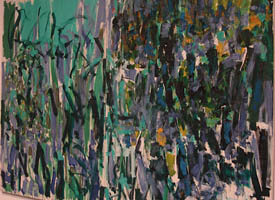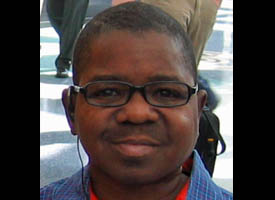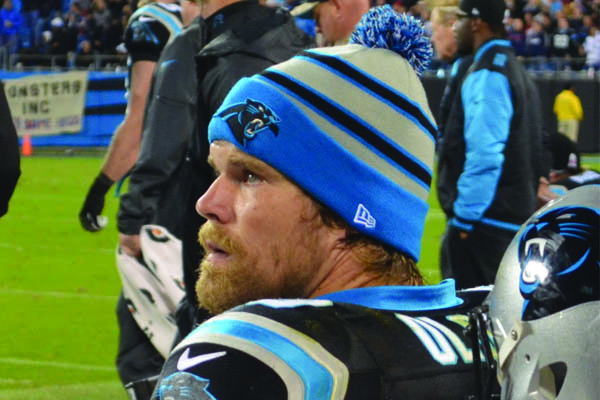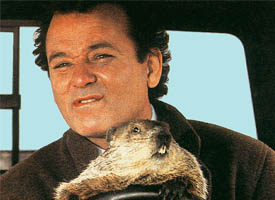- Details
 Joan Mitchell was an important abstract expressionist painter and print maker. She graduated from the School of the Art Institute of Chicago. A fellowship took her to France in 1948, where she began work in abstraction.
Joan Mitchell was an important abstract expressionist painter and print maker. She graduated from the School of the Art Institute of Chicago. A fellowship took her to France in 1948, where she began work in abstraction.
Mitchell is one of few women who are recognized as prominent figures in the abstract expressionist movement. Her work saw many changes over the years, work influenced by Vincent Van Gogh and Matisse.
She spent much of her life living and working in France; however she was monumental in shaping the New York art scene of her time. Mitchell provided generous support, to young artists, and created a foundation to recognize individual artists.
Learn more:
View some of her work and learn more about her here (The Joan Mitchell Foundation)
- Details
 “Diff’rent Strokes” actor Gary Coleman was born February 8, 1968, in Zion. He was famous for his role as an African-American orphan who was taken care of by a wealthy white father and his daughter. Coleman was known the world over for his phrase, “What’choo talkin’ bout, Willis?”
“Diff’rent Strokes” actor Gary Coleman was born February 8, 1968, in Zion. He was famous for his role as an African-American orphan who was taken care of by a wealthy white father and his daughter. Coleman was known the world over for his phrase, “What’choo talkin’ bout, Willis?”
Coleman, who is best known for the popular NBC show, started his acting career at the age of 8 on a show called “Medical Center.” Coleman would also make appearances on “The Jeffersons,” “Married with Children,” “The Simpsons,” and “My Wife and Kids.”
In 2003, Gary Coleman was a candidate for governor of California during the recall election. His campaign was supported by an outside group, and Coleman supported Arnold Schwarzenegger for governor. Coleman, though, would come in eighth place in a field of 135 candidates receiving more than 14,000 votes.
Coleman also owned his own company, Gary Coleman Productions.
Learn more:
Read more about the life of Gary Coleman on IMDb (http://www.imdb.com/name/nm0171041/)
- Details
 Ronald Reagan was born to Nelle and John Reagan in Tampico on February 6, 1911. He attended high school in nearby Dixon and worked his way through Eureka College, where he studied economics and sociology, acted in school plays and played on the football team.
Ronald Reagan was born to Nelle and John Reagan in Tampico on February 6, 1911. He attended high school in nearby Dixon and worked his way through Eureka College, where he studied economics and sociology, acted in school plays and played on the football team.
After graduating from Eureka College, Reagan became a radio sports announcer. In 1937, he won a contract in Hollywood and appeared in 53 films during the next two decades. Wanting to take a leadership role in the film industry, Reagan served as president of the Screen Actors Guild from 1947 to 1952.
In 1966, Reagan was elected governor of California and was re-elected in 1970. He took his political aspirations to the national level and was elected president of the United States in 1980 and 1984.
Reagan’s upbringing in Illinois instilled in him the values of hard work and patriotism that helped him succeed in acting and politics.
Learn more:
- Details
 You may see some familiar faces during the Super Bowl this Sunday. The following players and coaches have ties to Illinois:
You may see some familiar faces during the Super Bowl this Sunday. The following players and coaches have ties to Illinois:
- Jared Allen - played for the Chicago Bears in from 2014-15.
- Greg Olsen - was selected by the Chicago Bears as the 31st overall pick in the 2007 NFL Draft.
- Ron Rivera - won Super Bowl XX as a Chicago Bear and later served as a defensive coordinator.
- Steve Wilks - defensive backs coach for the Chicago Bears from 2006-08.
- Mike Shula - tight ends coach for the Chicago Bears from 1993-95
- Pete Hoener - coached for Illinois State, Illinois and the Chicago Bears.
- Ricky Proehl - wide receiver for the Chicago Bears in 1997.
- Richard Rodgers - linebacker/wide receiver for the Chicago Bruisers (AFL).
- Eric Washington - coached at Northwestern and with the Chicago Bears.
- Trevor Seimian - played quarterback at Northwestern.
- Owen Daniels' - hometown is Naperville, IL.
- Michael Schofield's - hometown is Orland Park, IL.
- Reggie Herring - was a linbackers coach for the Chicago Bears in 2014.
- Eric Studesville - was a running backs coach for the Chicago Bears from 1997-2000.
- Details
 It isn't really a "tiny town in Western Pennsylvania." It's Woodstock, IL.
It isn't really a "tiny town in Western Pennsylvania." It's Woodstock, IL.
In 1992, Woodstock became the temporary home for the filming of most scenes of the now-classic comedy movie, "Groundhog Day." Woodstock is a far northwest suburb of Chicago, about 10 miles from Wisconsin.
Illinois native Bill Murray, Andie McDowell, Chris Elliott, director/writer (and Illinois native) Harold Ramis and the rest of the cast and crew came to Woodstock to film a comedy about a news reporter who goes to Punxsutawney, Pa., to cover the annual Groundhog Day festivities, where a group of local officials drag poor groundhog Punxsutawney Phil out of his hibernation. If the critter sees his shadow, it supposedly means six more weeks of winter. Weather keeps the reporter and his crew overnight, but he begins waking up to the same day every day.
Woodstock has capitalized on the notoriety with a weeklong festival, including walking tours of the iconic sites in the movie. The film also brought greater attention and tourism to Punxsutawney itself. Bill Murray and Harold Ramis have both served as honorary grand marshal for the Groundhog Day celebrations in Punxsutawney.
"Groundhog Day" is ranked #8 on the American Film Institute's list of the 10 greatest films in the genre "Fantasy."
More Articles …
- Did You Know? Illinois was the first to ratify the 13th Amendment on this day in 1865
- Did You Know? Jean Baptiste Point du Sable was the first settler of Chicago
- Did You Know? Illinois man built the first tower silo
- Did You Know? Illinois ranks number one for green building efforts
- Did You Know? Today is the anniversary of the Chicago Bears Super Bowl XX win





